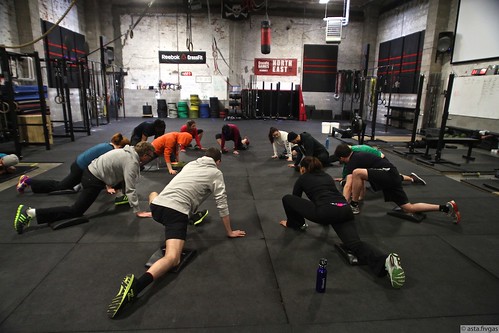
CFSBK has always offered a free introductory class every week, open to the public. This class occurs after our normal classes have ended on Sundays at 2:15pm and is a great way to introduce interested people to both CrossFit and the general culture of our gym, before they sign up for Foundations. From what I can tell, it seems that most affiliates offer a class like this, so you probably agree that it’s a critical space to create given the kinds of gyms we run and the buy-in for most Foundations programs (usually a significant monetary and time investment). Particular affiliates and CrossFit in general won’t be right for everyone, so it’s important to let people test the proverbial waters to assess whether your gym is a good fit. While many of our participants in Foundations take the plunge without attending our “Teaser” class, it’s still a service to the CrossFit-Curious who may one day become integral members of our communities.
The total length of CFSBK’s intro class is one-and-a-half hours and we cap it at 20 people, who have to RSVP ahead of time. On average, 10-15 people actually show up but the cap is intentionally set beyond what we expect.
In today’s article, I’ll walk through the basic programming (with approximated time stamps on each section), and address the intentions of our class and offer some thoughts about how we run it. My hope is that you will steal some of our programming and share with the ITA community what’s worked best for you.
Introductions (3-5 Minutes)
Once the time hits 2:15pm exactly (reflecting the promptness they can expect in group classes), I start the class by having everyone grab an AbMat and form a big circle. I welcome everyone and introduce myself, then I state the three intentions of the class:
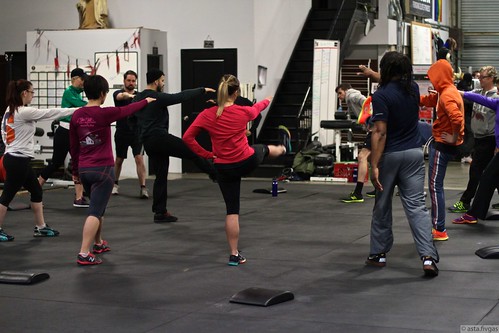 1. Introduce people to both CrossFit in general and a typical group.
1. Introduce people to both CrossFit in general and a typical group.
2. Introduce them specifically to our gym, noting that CrossFit is not a franchise and every gym is a unique little snowflake. Tell folks they might need to shop around and find the place that suits them.
3. Admit that some of the people here will never come back, which is terribly sad but something I’ve come to terms with. Beyond getting a workout in today, I’ll try to teach two different concepts/practices that they can take with them beyond this class, regardless of how they choose to proceed. (These lessons are the importance of squatting well and regularly and why quantifying one’s performance metrics is important.)
Then I tell people to listen to their bodies, ask questions, and not to worry about being a superstar—just move well and HAVE FUN.
Movement Prep (5-10 minutes)
Next I’ll take folks through some basic dynamic range-of-motion (DROM) movement prep followed by some ground-based hip openers. (The AbMat can come into play here as a knee cushion.)
We then start DROMs and I ask everyone to tell us their name and what brought them to CFSBK today. I try to make this class feel like a mini group class, and given how popular our Question-of-the-Day is, I include it here too. Especially with a room full of new people, if you can have some fun with it, it breaks the ice a little and gets people laughing.
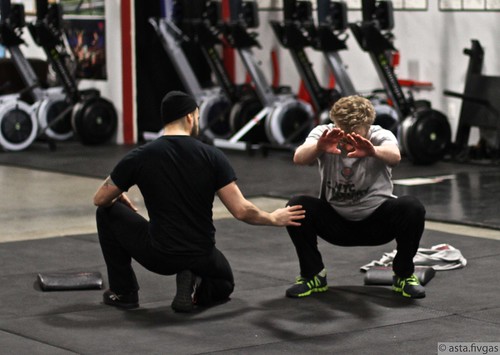 Triplet Warm-Up (10-12 minutes)
Triplet Warm-Up (10-12 minutes)
I start by explaining that squatting is a very basic part of human physical vocabulary and unfortunately has been mostly eliminated in industrialized societies as a common posture. By not moving regularly through this range-of-motion, preventable hip, ankle, and knee dysfunction become more prevalent, in addition to common lower back pain and greater decrepitude in old age. You don’t need a doctor’s note to do something your ancestors have been doing for the past 200,000 years. So, basically, I tell them: Learn to squat and start performing squats on a regular basis. Again, this is one of the two key points I want people to take from the class, regardless if falling in love with CrossFit is in their future.
Next, I’ll demo and lead the class through repetitions of each of the following movements, reinforcing points of performance and ensuring people are moving well.
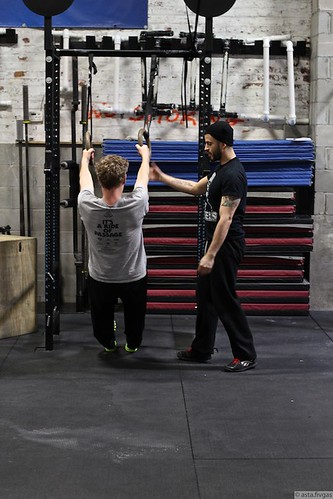 15 Air Squats
15 Air Squats
15 AbMat Sit-Ups
10 Ring Rows or 3-5 Strict Pull-ups
After the first round of the triplet, I ask the class to perform two more rounds at their own pace. While this is happening, I walk around troubleshooting on an individual basis and also provide some cueing to the group, such as “Remember to push your hips back and keep your knees out during squats” and “Don’t slouch at the bottom of your ring row, stay long and tight!”
Workout of the Day Movement Review (10 Minutes)
After a water break, I explain that we’re going to do a workout with three different movements, which we’ll review. From week to week, we cycle through a few different WODs contingent on weather, class size, and my mood. For the purposes of this article, I’ll focus on a standard triplet WOD I use, that includes running, burpees, and dumbbell thrusters.
I invite folks to come over to the dumbbell storage area and tell them which dumbbells they should grab, explaining that I’m eyeballing what’s appropriate for them. I assure them they can change their weights later if their initial selection isn’t right. (This is another time it really helps to have your dumbbells properly labeled.) During this class, we break out the old medball squat target, simply because new people will be more likely to squat well if they have a tactile target for every single rep, reinforcing hips-back initiation.
After I take the class through a short thruster progression, we move on to burpees. I take the class through three different versions, starting with the easiest and then scaling up. I inform them to choose the version that they can perform the most consistently and correctly in the workout, and again remind them that they can always scale down.
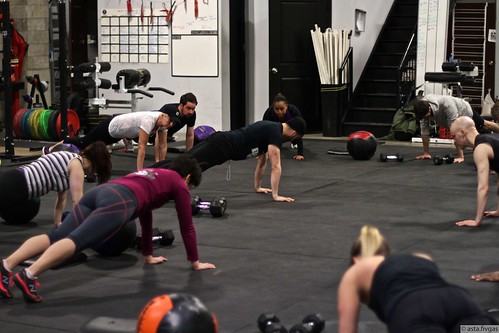 Version 1: Non-dynamic squat thrust with one second pause at top of tall plank position
Version 1: Non-dynamic squat thrust with one second pause at top of tall plank position
Version 2: Dynamic squat thrust with sprawl out and walk in
Version 3: Hand-release burpee
I start by showing a strict push-up and a knee push-up, and note that either is acceptable. If they can’t do a knee push-up through a full range-of-motion and with good form, they should do one of the first two versions. I include the hand-release version simply to keep people who are doing push-ups accountable to a full range-of-motion.
Workout of the Day (15 Minutes)
After the movement review, we gather around the white board and I describe the workout. I explain the run course (to the end of our long block and back) and that they can break up the sets of burpees and thrusters into smaller sets as needed. I also emphasize that they want to move for 12 minutes continuously, not sprint out of the gate and torch their energy in the beginning. In this workout, I emphasize that they should keep their first rounds in the context of the entire 12 minutes and start off at 70% perceived intensity and maintain a sustainable pace.
AMRAP 12 Minutes:
Run 270m
12 Burpees
12 Dumbbell Thrusters
When the 12 minutes is over, I have everyone walk together to the end of the block and back, then put away their dumbbells and medicine balls. If we’re running well on time, I might add some DROMs or teach them to foam roll their quads and lats as a cool down. During this time, I also invoke some banter about the workout—soliciting their thoughts on the worst parts and letting them know to expect to be sore tomorrow, and that the best way to deal with it is to move around and stay hydrated.
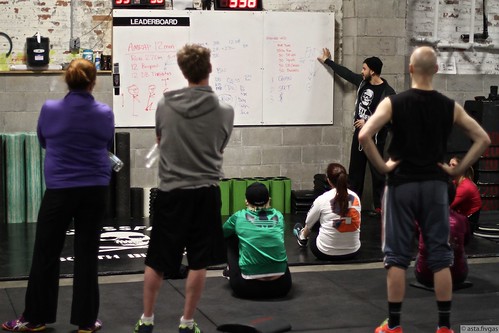 Exit Lecture (10+ Minutes)
Exit Lecture (10+ Minutes)
Here is where I’ll talk a little about “what just happened to you” and say more about CrossFit in general. What this looks like: first, I’ll invite someone to note their stats on the workout. I’ll go through and show how he or she could eventually recreate this workout using the same weights and standards to test whether they improved. This highlights my second point—that some or all aspects of your fitness need to be quantifiable. I mention that if you don’t track performance markers, then you can’t be sure you’re making progress. In CrossFit, we always quantify our workouts and keep training journals, which enables people to see their progress clearly. Next, I say that we use movements that borrow from other disciplines such as weightlifting (an example being the dumbbell work, though we mostly work with barbells), gymnastics, body weight movement (such as the burpee), and monostructural movement (such as the run). All of this shows that CrossFit is a broad and inclusive fitness program intended to make you a well-rounded athlete.
We finish with questions and briefly discuss Foundations as a prerequisite for group classes. I thank everyone for coming, tell them to get membership information at the front desk, and shake everyone’s hand. I know the class has gone really well when it concludes with unprompted applause.
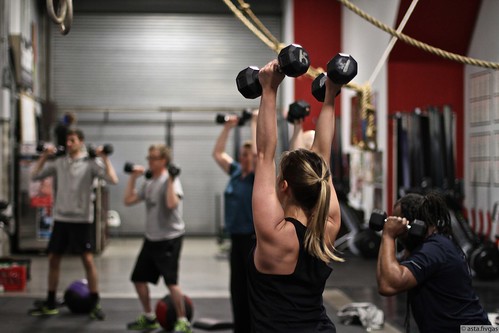 Additional Reminders
Additional Reminders
1. Take their questions seriously
Don’t be cynical or defensive when a woman yet again asks you if she’ll get too bulky by lifting weights, or if someone says he’s heard CrossFit is dangerous and that makes him hesitant to sign up. People are going to have an abundance of questions that you’ve heard and answered an abundance of times, but remember: they’re new to this stuff, and so it’s on you to answer honestly and with empathy. Do you want these people to join your gym? Act like it.
2. Set the tone
People do things because they’re fun. We like goals in CrossFit, so consider it your goal to make this the most interesting and engaging part of these peoples’ day. I crack the same damn jokes almost every single class because they consistently elicit laughs and lighten the mood. Making a class “hard” isn’t good enough. Remember that the intensity of CrossFit speaks for itself, and it takes tact and emotional intelligence to transform something that’s hard into something that’s also enjoyable and accessible.
3. Don’t be stupid
As mentioned above, the point of these introductory classes are to provide people with a personal window into your gym and CrossFit in general. Be a professional, scale accordingly, and make sure people aren’t exerting themselves beyond a reasonable capacity. I want someone to sign up because I convinced them that we run a tight ship and have the resources to keep them fit and safe; not because we have the ability to crush them with an exhausting workout one day. Here’s an easy perspective changer: teach these classes as though your mom was in it.
How do you run your intro classes?
________________________
See more shots from our Teaser class here